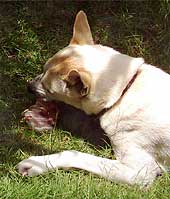 Regardless if one has been a dog owner all his or her life, seeing a dog scooting its rear end across the yard or living room carpet always tends to be an unsettling sight.
Regardless if one has been a dog owner all his or her life, seeing a dog scooting its rear end across the yard or living room carpet always tends to be an unsettling sight.
Dog Scooting on Bottom-Whats the Cause?
However, experienced dog owners know this is an issue that should never be ignored; especially since it is a symptom of a worm or flea infestation. Yet when the scooting is accompanied with excessive licking of the anal area or difficulty defecating, it is likely a different but very important health issue: impacted anal glands. Left unchecked, impacted anal glands can lead to serious infections in addition to painful abscesses for a canine companion.
How Blocked Anal Glands Cause Dog Scooting Bottom on Floor
The anal glands are two sacs that are located on both sides of a dog’s anal opening. The secretions inside them are what a dog uses to leave his or her scent behind. When a proper sized stool of the correct hardness is passed, it presses up against these glands that then leave a deposit as the dog defecates.
However, when a dog’s stool is consistently soft, the anal glands can become backed up and that’s when pet owners see their dog scooting around on its rear end. Backed up anal glands are uncomfortable for a dog and recurrent problems leave the door wide open for bacterial infections.
It is not uncommon for dog owners to take their canine companion to a vet or groomer to have a blocked anal gland expressed. While this certainly brings relief for a scooting dog, there are pet owners that find themselves having to have this procedure done nearly every two weeks. This is an indicator that something is seriously wrong in a dog’s diet. In addition, the constant expression can lead to soft tissue trauma of the anal glands.
How Diet Plays it’s Role in Dog Scooting
About 70% of the time, it is because a dog subsists on a diet of canned commercial pet food. The inability to form a hard stool while ingesting such a diet is what has a dog scooting around its rear end in hopes of unblocking the gland and finding some relief.
Rather than putting a canine companion through a constant, uncomfortable cycle, the better kindness pet owners can offer is a diet change to natural raw meat diet. A diet of raw meat and bone is not only the key to healing a vast number of canine ailments, dogs on this type of natural diet pass firm, odorless stools. Within weeks, a dog and it’s owner can see the end of this costly and unpleasant cycle for good.
As stated by Dr. Tom Lonsdale, BVet Med, MRCVS, “A natural diet acts as food and medicine for pet carnivores. It works wonders and minor miracles. We need those benefits now.”
Watch the short video below to discover more about a dogs optimum diet
How Natural Dog Health Food Prevents Dog Scooting on Carpet
Unlike commercial pet foods where much of their diet passes undigested, dogs on a diet based around raw meat and bone will use every bit of what they eat. Firm stools properly work the anal glands, which means infections and abscesses become a non issue. Most importantly, thanks to a diet of raw meat and bone, dog owners no longer have to see the unsettling sight of their dog scooting their rear end on the new living room carpet.
Get the free report below and find out more about how you can get your dog to ultimate health and stop nearly all health problems for life.




Hey Dan, thanks 4 the article – let me be the 1st to comment! We’ve fed our 3 yr old pug on Raw food – mainly chicken thighs and bones – since he was a puppy. He still has discomfort from his anal glands, especially in the hot summer months (it gets up to 35C here). It seems to be relieved slightly for a few days by expressing; but only a few days, and only a slight relief. I thought the raw diet should prevent this; but his stools are soft in the summer, so maybe that’s the problem? Anyway, would adding fibre be an answer? What form? I thought the whole point about raw was to avoid fibres, grains etc Thanks!
Hi, is that the famous Pancho “El Lomo” Mentalista?
Sometimes even a raw food diet won’t help with anal glands. Reasons are odd placement of glands in exit area that don’t get expressed by outgoing bone content waste, soft tissue trauma etc. The adding of fibre is by vegetable matter such as broccoli, yam, kale etc.
Also try rounding out the diet with 2-3 different proteins, raw tripe, some mashed veg matter and the addition of some organs such as liver.
4-5 days a week feed meat/egg/veg/tripe/organ mix and 2 days meaty bones only to get hard stools. Also give filtered/bottled water only – not tap!
And keep him slim… and no treats which can lead a small to getting sick/soft stools.
Hopefully some of this helps, let me know if I can help further.